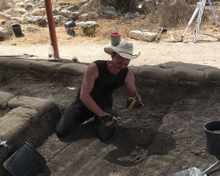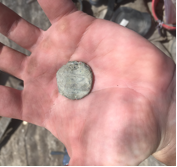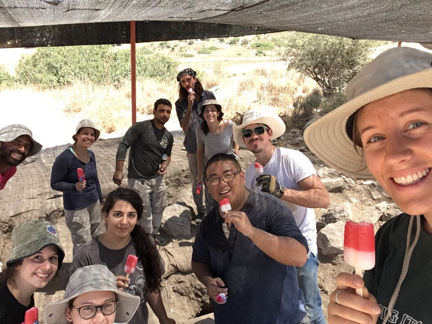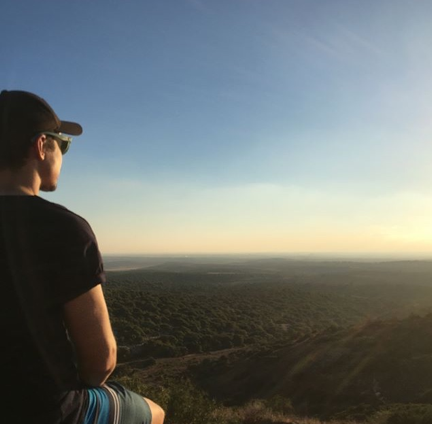
WHAT ON (AND BELOW) EARTH HAPPENED HERE?
Katlin Long-Wright, 2018 G. Ernest Wright Fellowship Recipient
In the heart of the Judean foothills on the Shephelah plane, is the site of an ancient story. The name of this site is Horvat Midras, a group of four areas each with its own mystery and allure. Area A consists of a large structure with an orthogonal layout, bases for columns, a decorated lintel, and a cistern dating to the Byzantine period. Area C consisted of retaining walls and a thick layer of homogeneous pottery dating to the 1st and 2nd C. BCE; the area was classified as a midden and closed in 2017. Area D is a tomb marked by a large stepped pyramid. There are no inscriptions or markers that would indicate who was buried within, yet such an impressive burial must have been for an individual of significant social and economic power. The search continues. Last, is Area B, which I was fortunate enough to excavate for its tale is the most mysterious of them all.
Above ground Area B consisted of destroyed walls, damaged floors, and the entrance to a cistern; ruins of modern habitation. Below ground was another story. Excavation of the cistern in 2017 revealed a tunnel leading to a another room. The goal for this season is to excavate further and attempt to explain what had happened at the site. During the survey, Area B supervisor Tal Ragovski accidentally discovered another cave entrance when he stuck a measuring tool into the ground and it sank, disappearing into the ground below. A square was opened where he serendipitously discovered the second cave entrance. It was in this square of Area B that I excavated along with my classmates and dig supervisor Shir Hoorit of Hebrew University.
The weather was oppressive; the heat had reached 104 degrees Fahrenheit, the wind raged, and the clouds disappeared quickly providing little to no reprieve from the scorching sun. Despite Mother Nature’s attempt to deplete our team of strength, the desire to uncover the secrets of the square outweighed the discomfort. After week one, the plot thickened with the discovery of two walls. The larger, and longer, of the two was comprised of two different masonry styles. The two foundational courses belonged to a Roman period while the course above was Byzantine. The smaller wall, dated to the Mamluk Period. Three different occupation layers, and all of them constructed around the cave entrance. For what purpose?
By the end of week two we had uncovered two more walls, however, one was in fact not a wall but a coincidentally well placed collapse. In the second week the discovery of Roman and Byzantine ceramics became daily and frequent, this helped the team determine that we were reaching earlier occupation layers. A large amphora dating to the Roman Period was discovered next to one of the walls. Although damaged, the contents were sent for analysis. Several tiny bits of charcoal appeared the further down we excavated. A blade was also found and several numismatics, one was identified as Byzantine (a distinctive M could be seen).Who built near this cave entrance, and why?
By the end of week three, the cave entrance was fully revealed. A rock hewn arch served as the top of the cave entrance. It was only a few feet below the foundational stones of the walls for the structure. Unfortunately, we reached the collapse of soil into the cave entrance on the third last day of excavation, leaving us no time to excavate that part of the cave. So, who made this cave, and why? Based on the ceramics, artifacts, numismatics, and layout of the cave the supervisors and excavation team determined it was a hiding complex used during the Bar Kokhba Revolt. The cistern was originally used as a miqvah, a Jewish ritual bathing installment. During the Revolt period, the Jewish people would carve through their miqvah and connect it to their underground storage room. They would then dig towards a neighbour’s miqvah and storage room creating a complex network of caves. When the Romans would come to attack, the inhabitants would run into the hiding complexes to escape capture or injury. Several hiding complexes have been discovered in the region, ranging in size and complexity.
This excavation was incredible! Unfortunately I could not multiply myself and excavate in each area of the site, but Area B provided more than enough training, and excitement. This season really solidified the idea that archaeology is a mystery solving discipline. Each clue must be taken into account if one wants to determine the story of a site. It’s not about a race to the finish but a methodical perusing of each layer, artifact, and feature to gain a clear understanding of what has transpired. I chose to write this entry in such a way that demonstrates what it is like to be in the field. Each hour, day, and week provides new information, and with that information comes new hypothesis. You are a detective trying to uncover the past, and you only have the evidence at the site, and examples from others, to draw upon. It is fascinating and fulfilling work, and I hope to be fortunate enough to don the trench hat once more in search of buried pasts.
A huge thank you to the American School of Oriental Research, without their financial support I would not have been able to attend the excavations of Horvat Midras in Israel.
Katlin Long-Wright is a Canadian and a graduate from the University of British Columbia’s Classical, Near Eastern, and Religious studies department. His research has an emphasis on Egyptology. He has worked on two excavations: Gerace, Sicily, and Horvat Midras, Israel, and hopes for many more excavation opportunities in the future.




